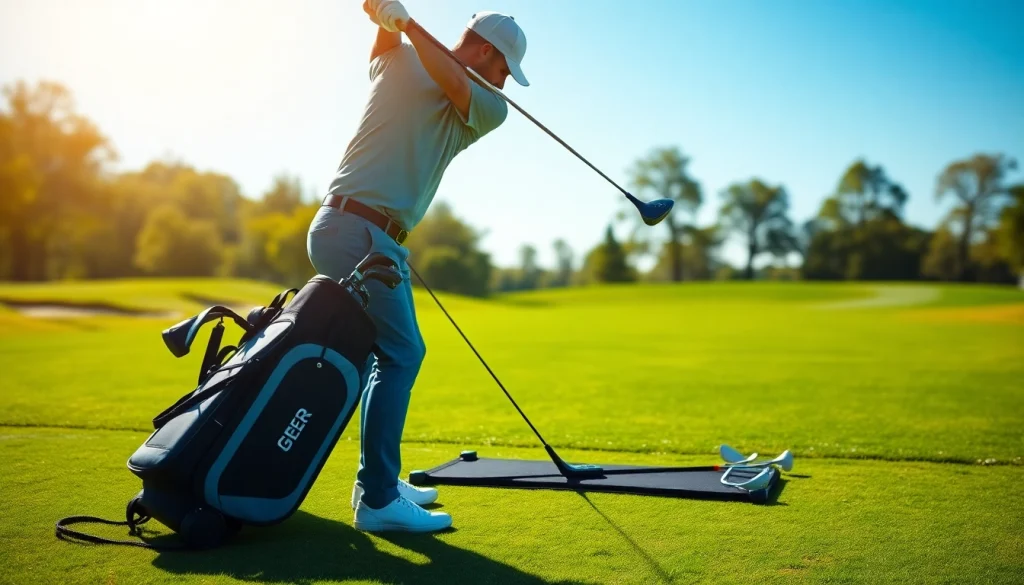Understanding Golf Swing Training Aids
What Are Golf Swing Training Aids?
Golf swing training aids are specialized tools designed to help golfers enhance their swing mechanics and overall performance on the course. These devices can range from simple alignment sticks to sophisticated digital systems that provide real-time feedback. Incorporating a golf swing training aid into your practice routine can lead to significant improvements in consistency, accuracy, and power.
Benefits of Using Training Aids
The primary benefit of using golf swing training aids is the ability to develop better habits without needing constant supervision. These aids promote muscle memory, which is crucial for a consistent swing. Additionally, they can identify specific areas of weakness, allowing golfers to focus their practice effectively. Other benefits include:
- Increased Engagement: Many training aids are interactive, making practice more enjoyable.
- Visual Feedback: Aids that provide immediate visual feedback help golfers understand their mistakes in real time.
- Customization: Depending on the golfer’s level, different aids can cater to specific needs, from beginners to professionals.
How to Choose the Right Aid for Your Needs
Selecting the appropriate golf swing training aid requires considering personal goals, skill level, and learning preferences. Here are key factors to take into account:
- Skill Level: Evaluate whether you are a beginner or an advanced player. Some aids are better suited for novices, while others are designed for fine-tuning advanced techniques.
- Goals: Assess what you want to improve—power, accuracy, or consistency—and choose aids specifically designed for those areas.
- Technology Usage: Determine your comfort level with technology, as some aids incorporate digital tools for feedback and analysis.
Types of Golf Swing Training Aids
Top Mechanical Training Aids
Mechanical training aids often take the form of physical tools that help golfers adjust their swing mechanics. Some popular types include:
- Alignment Sticks: These facilitate proper alignment and setups that are crucial for an effective swing.
- Weighted Clubs: These improve strength and help promote a correct swing path by building muscle specific to the golf swing.
- Impact Bags: These target the moment of impact, encouraging golfers to strike the ball with the correct angle and force.
Digital and Technological Solutions
With advancements in technology, digital training aids have emerged as game-changers in golf training. Available products include:
- Swing Analyzers: These devices collect data on swing speed, path, and angle, providing insights for improvement.
- Smart Sensors: Attach these to your club to receive detailed feedback through a smartphone app.
- Virtual Reality Systems: Immersive systems that simulate real golfing conditions for a comprehensive training experience.
Accessories for Enhancing Swing Mechanics
In addition to primary training aids, several accessories can further enhance your training experience:
- Grip Trainers: These assist in developing the proper grip and hand positioning on the club.
- Mirror Systems: Use these to analyze your posture and swing in real-time, allowing for immediate correction.
- Anti-Slice Devices: Devices designed to help golfers overcome common issues like slicing, promoting a straighter shot.
How to Use Golf Swing Training Aids Effectively
Best Practices for Technique Improvement
To maximize the effectiveness of golf swing training aids, it’s important to follow certain best practices:
- Consistency: Regularly practice with your training aid to reinforce what you’re learning.
- Focused Sessions: Set specific practice goals for each session to track your progress and improvements.
- Record Progress: Keep a log of your practice sessions, noting changes and improvements over time.
Integrating Training Aids into Your Routine
For best results, you should integrate these aids into your overall practice routine. Here are some suggestions:
- Warm-Up: Use a training aid as part of your warm-up routine to get your muscles accustomed to the motions.
- Alternate Practice: Mix traditional practice with aid-based practice to develop a well-rounded skill set.
- Evaluate Progress: Regularly assess your performance to adjust your training routine as needed.
Common Mistakes to Avoid
While using training aids can greatly enhance your skills, avoiding certain pitfalls is important. Common mistakes include:
- Over-Reliance: Avoid depending solely on aids; they should complement, not replace, traditional practice.
- Infrequent Use: Inconsistent practice with aids can hinder your development.
- Lack of Professional Guidance: Seek feedback from a pro to ensure the correct usage of training aids for maximum benefit.
Measuring Success with Training Aids
Setting Achievable Goals
A critical aspect of utilizing training aids effectively is establishing clear, realistic goals. Consider the SMART criteria when setting your objectives:
- Specific: Define clearly what you hope to achieve (e.g., improve swing speed by 5 mph).
- Measurable: Set metrics to assess your performance and progress.
- Achievable: Ensure that the goals are realistic based on your current skill level.
Tracking Progress Over Time
Monitoring your development over time allows you to see patterns and make necessary adjustments. This can be accomplished through:
- Data Analysis: Review swing metrics provided by digital aids to identify trends.
- Video Analysis: Record practice sessions to visually assess improvements and identify areas requiring more work.
- Performance Journals: Keep a log of scores and any perceived improvements associated with your training aid usage.
Adjusting Your Strategy Based on Feedback
Feedback is crucial for improvement. Adjusting your training methodology based on insights gained from using the equipment can enhance progress. Follow these steps:
- Review Data Regularly: Analyze your metrics frequently to understand which areas need focus.
- Seek Professional Insight: Consult a coach for advice on interpreting your data and making necessary changes.
- Be Flexible: Don’t hesitate to change your practice tactics if you’re not seeing the desired results.
Case Studies and User Testimonials
Success Stories from Amateur Golfers
Many amateur golfers have turned their game around utilizing swing training aids. For instance, a 32-year-old golfer documented a 10-stroke reduction in his average score after incorporating an impact bag into his routine. By focusing on improving his striking technique, he ultimately improved his confidence on the course.
Insights from Professional Players
Even professional players recognize the value of training aids. A notable PGA Tour competitor reported using smart sensors to refine his swing mechanics during practice sessions. Feedback from these aids enabled him to shave off critical strokes during tournaments.
What the Data Says About Performance Improvement
Research indicates that golfers who regularly employ swing training aids often see marked improvements in various performance metrics, such as:
- Swing Speed: Data shows measurable increases in swing speed for athletes using weighted clubs during practice.
- Accuracy: Users of alignment sticks reported a higher percentage of fairways hit, demonstrating the aids’ effectiveness in promoting better aim and direction.
- Consistency: Analysis suggests that golfers who commit to a structured training aid regimen often achieve more consistent shot patterns over time.


